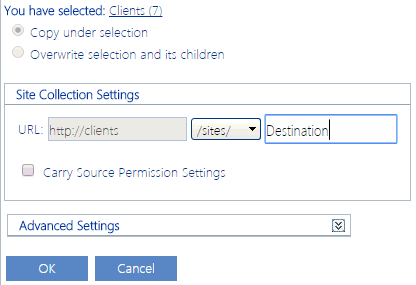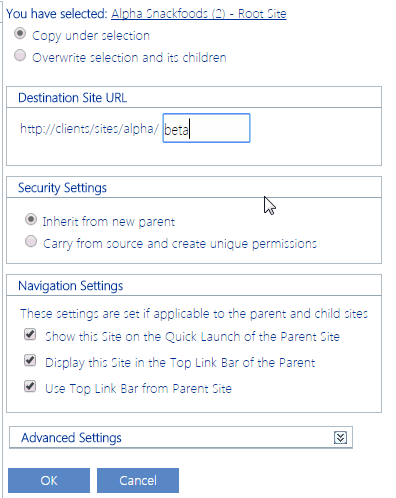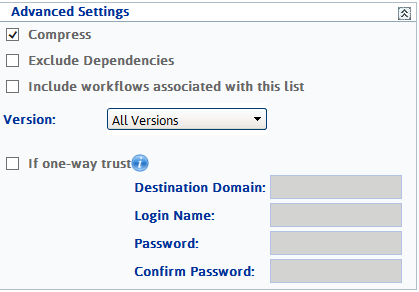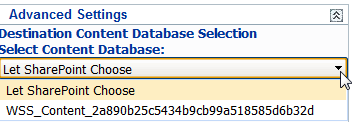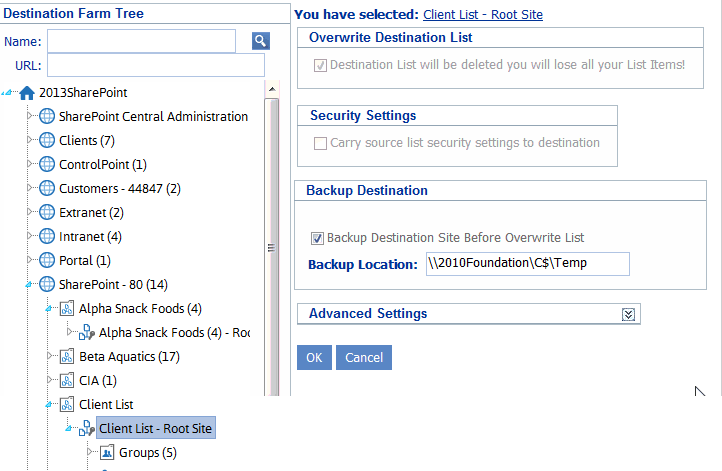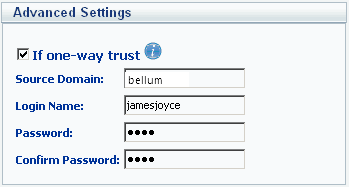Moving a Site Collection or Site
The ControlPoint Move Site action lets you move the configuration, content, and/or permissions of a site collection or site from one location to another, either within the same farm or across farms.
Once a site collection is deleted from the source content database, any activity and audit log data associated with it remains but becomes "orphaned." If ControlPoint audit log archiving has been set up for the farm, audit log data can be archivedand purged from the database before the site collection is deleted. See Archiving Audit Log Data Before Moving or Deleting a Site Collection . The site collection in the source content database will display as a deleted site collection in Site Collection Activity results only if it was active during the period covered by the analysis.
REMINDER: Copy/Move actions are available only if ControlPoint was first installed prior to version 8.1.
Before you move a site collection or site:
Be sure to review Factors to Consider Before Performing a Copy or Move.
To move a site collection or site:
1In the SharePoint Hierarchy, select the site collection or site you want to move. (Note that you can only move one site collection or site at a time.)
2Right-click and choose Content > Move Site.
3Use the information in the following table to determine the appropriate Source Site Content Settings option to select.
|
If you want to copy the site collection or site's ... |
Select ... |
|---|---|
|
·configuration (that is, properties that have been defined for the site, such as theme, templates, and default lists) ·site content (lists and libraries, documents and list items), and ·child sites |
All Content. |
|
configuration and site content (not child sites) |
Limited Content. |
|
configuration only |
No Content. |
4Specify the following Destination Settings:
a)For Temporary Location, specify the folder path to which you want to export source files. (ControlPoint Application Administrator may have also specified a default temporary location to use.)
REMINDER: The account you are using to perform the operation (and in the case of cross-farm operations, the Service Account(s) of both the source and destination farm) must have Full Control access to the Temporary Location, both to the folder itself and to the share.
b)If you are performing a cross-farm operation:
§ select a Destination Farm from the drop-down
OR
§enter the location of the destination farm in the format http://<server_name:port_number> or or <hostname>
where port_number is the port number used for the ControlPoint Web application. 1818 is the ControlPoint default.
NOTE: You can perform cross-farm operations only if both farms are managed in ControlPoint. For additional requirements and considerations, see Special Consideration for Copying or Moving Across Farms.
c)Click the Destination Url: [Select] button to open the Destination Selection page.
5 If you selected a Destination Farm that is different than the source farm and you want to select a different user account to carry out the portion of the operation that occurs in the destination location, use the Sign in as Different User option in the upper-right corner of the Destination Selection page. (Note that this option will not be visible if the source and destination are within the same farm.)
6Use the information in the following table to determine the appropriate actions to take.
REMINDER: Make sure you are familiar with How Security Settings are Handled at the Copy/Move Destination.
|
If you chose to ... |
Then ... |
|---|---|
|
create a site collection |
·Enter the URL path for the new site collection. ·If you want to carry security settings over from the source site, check the Carry Source Permission Settings box. |
|
overwrite a site collection or site |
·If you want to carry security settings over from the source site, check the Carry Source Permission Settings box. ·If you want to back up the destination site collection or site to a CAB file before overwriting it: §check the Backup Destination Before Overwrite box, and §enter the UNC path to the folder to which you want to export the destination site collection/site before it is overwritten. It is strongly recommended that you always back up destination site collections/sites that are to be overwritten. If an error occurs during the operation, the import of the source site will be rolled back, but the deleted/overwritten site will have to be restored manually.
The Backup Location you specify becomes the default backup location for future copy and move operations that you perform (that is, it is a user-specific location). You can restore sites from the backup location using standard stsadm import procedures. |
|
create a subsite |
·Enter the Destination Site URL path ·Select the appropriate option for Security Settings; either: §Inherit from [site_name] (if you select this option, all child sites, lists, and libraries will inherit permissions from the destination parent, even if they had unique permissions on the source site), OR §Carry from source and create unique permissions (if you select this option, all permissions from the source site (both inherited and unique) will be carried over and set as unique permissions on the destination site.) ·Check each of the Navigation Settings you want to carry over to parent and child sites. |
7If the source and destination are in different domains with a one-way trust relationship and the source domain does not trust the destination:
a)Expand the Advanced Settings section.
b)Check the If one-way trust box.
c)Enter the Source Domain name, Login Name, and Password.
NOTE: If the destination domain does not trust the source, you will need to complete corresponding fields on the main page.
8If you are creating or overwriting a site collection and more than one content database is attached to the Web application, select the content database that you want to use from the Select Content Database drop-down.
NOTE: The drop-down displays content databases that are currently online and for which the Maximum Number of Sites has not been reached. If you do not want to specify a database, accept the default value Let SharePoint Choose.
9Click [OK] to return to the Move Site main page, with the Other Settings section populated with the options you selected.
10Complete the Delete Source Settings section as follows:
a)If different from the default (10 days), enter the number of days after the move that you want the site collection/site deleted from the source location.
NOTE: If you are moving an active site collection or site, it is recommended that you either lock the site collection to prevent changes or delete it within a day of a successful move because any changes to the source after the move is carried out will not be replicated to the destination.
b)If you want to back up the source site collection or site to a .CAB file before it is deleted:
§make sure the Backup Before Delete box is checked, and
§specify a network folder path to which you want to export the backup file.
It is strongly recommended that you make a backup of the source, especially if security settings will be changed and/or content will be overwritten. You must have Full Control permissions to the Backup Location you specify, and it becomes the default location for future move operations that you perform (that is, it is a user-specific location). You can restore sites from the backup location using standard stsadm import procedures.
11If the source and destination are in different domains with a one-way trust relationship and the destination domain does not trust the source:
a)Expand the Advanced Settings section.
b)Check the If one-way trust box.
c)Enter the Destination Domain name, Login Name, and Password. (Remember that the account you use must be in the ControlPoint Remote Service Account Administrators (RSAA) group.)
NOTE: If the source domain does not trust the destination, you will need to complete corresponding fields on the Destination Selection page.
Additional options in the Advanced Settings section may be used in special circumstances. For example:
§If you want to Compress content during export, check this box.
NOTE: If your selection includes one or more exceptionally large documents or list items an attempt to perform a copy/move operation may result in Out of Memory exception as files are being exported. (Compression of exceptionally large list items may consume a lot of memory.) This is why the Compress option is unchecked by default.
§If the site contains certain kinds of dependencies (such as a reference to another site), and you want those dependencies to be included at the destination, uncheck the Exclude Dependencies box.
NOTE: If you choose not to Exclude Dependencies, you may encounter an error when the export process attempts to capture the content being referenced. This is why Exclude Dependencies is checked by default.
§If you want to Include workflows associated with selected content, check this box.
NOTE: For information on workflow components that ControlPoint will and will not copy or move, see How Content is Handled When Copied or Moved.
By default, ControlPoint copies all versions of lists or libraries. However, compatibility issues may exist with old versions. For example, if an old version of a Web Part page contains a Web Part that no longer exists on the system, you may encounter an error. You can choose, instead, to copy only the Current version, Last Major, or Last Major and its Minor.
Now you can:
·run the operation immediately (by clicking the [Run Now] button)
OR
·schedule the operation to run at a later time or on a recurring basis.
OR
·save the operation as XML Instructions that can be run at a later time.
If you choose to run the action immediately, an Action Verification dialog displays with a summary of the options you chose. Review these options, then click [OK] to continue.
When the process has completed, one of the following messages displays on the Action Verification dialog:
§Process Completed -
ControlPoint completed the operation without errors.
§Process Completed with Some Errors -
ControlPoint completed the operation, but with some errors; for example, an orphaned user was found in a group that was copied.
§[error_message_text]
An error occurred that prevented ControlPoint from completing the operation.
NOTE: If you chose to overwrite an object and an error occurs during the backup (export) of the destination site, ControlPoint will stop processing the operation regardless of the nature of the error, to prevent the destination site from being deleted before the problem can be corrected.
Click [OK] to generate a ControlPoint Task Audit, which provides detail about the progress of the operation, including any errors that have occurred.
If you schedule the action, a link to the Task Audit is included in the scheduled action notification email.
See also The ControlPoint Task Audit.
Copying a List or Library
The ControlPoint Copy List action lets you copy the configuration and contents (and optionally, security settings) of a SharePoint list or library from one site to another, either within the same farm or across farms.
NOTE: You can only copy one list or library at a time, and the operation includes all items. If you want to copy selected items or folders within a list or library, use the procedure for Copying List Items.
REMINDER: Copy/Move actions are available only if ControlPoint was first installed prior to version 8.1.
Before you copy a list or library:
Be sure to review Factors to Consider Before Performing a Copy or Move.
To copy a list or library:
1In the SharePoint Hierarchy, select the list or library you want to copy. (Note that you can only copy one list or library at a time, and the operation includes all items.)
2Choose Content > Copy List.
3Specify the following Destination Settings:
a)For Temporary Location, specify the folder path to which you want to export source files. (ControlPoint Application Administrator may have also specified a default temporary location to use.)
REMINDER: The account you are using to perform the operation (and in the case of cross-farm operations, the Service Account(s) of both the source and destination farm) must have Full Control access to the Temporary Location, both to the folder itself and to the share.
b)If you are performing a cross-farm operation:
§ select a Destination Farm from the drop-down
OR
§enter the location of the destination farm in the format http://<server_name>:<port_number> or <hostname>
where port_number is the port number used for the ControlPoint Web application. 1818 is the ControlPoint default.
NOTE: You can perform cross-farm operations only if both farms are managed in ControlPoint. For additional requirements and considerations, see Special Consideration for Copying or Moving Across Farms.
4Click the Destination Url: [Select] button to open the Destination Selection page.
5Select a site in the Destination Farm Tree. (If you select a site collection, the list will be copied to the root site.)
If the site you selected contains a list with the same name as the source, the list (and all of its item) will be overwritten with the list from the source site.
6 If you selected a Destination Farm that is different than the source farm and you want to select a different user account to carry out the portion of the operation that occurs in the destination location, use the Sign in as Different User option in the upper-right corner of the Destination Selection page. (Note that this option will not be visible if the source and destination are within the same farm.)
7Use the information in the following table to determine the appropriate Security Settings option to select.
|
If ... |
Then ... |
|---|---|
|
·you are copying a list with unique permissions, and ·you want to carry permission settings of the source list over to the list on the destination site |
check the Carry source list security settings to the destination. NOTE: If you check this box, a user group and its members will be carried over only if the group does not already exist on the destination site. This option is not available if you are moving between claims-enabled and non-claims-enabled Web application. |
|
you want the list to inherit permissions from the destination site |
leave the Carry source list security settings to the destination box unchecked. NOTE: If you are copying a list with inherited permissions, this is the only available option. |
8If you want to back up the destination list before overwriting it:
§check the Backup Destination Before Overwrite, and
§enter the relative path to the folder or url to which you want to export the destination list before it is overwritten.
It is strongly recommended that you always back up destination lists that are to be overwritten. If an error occurs during the operation, the import of the source site will be rolled back and the list can be restored using standard stsadm import procedures.
9If the source and destination are in different domains with a one-way trust relationship and the source domain does not trust the destination:
a)Expand the Advanced Settings section.
b)Check the If one-way trust box.
c)Enter the Source Domain name, Login Name, and Password.
NOTE: If the destination domain does not trust the source, you will need to complete corresponding fields on the main page.
10Click [OK] to return to the Copy List main page, with the Other Settings section populated with the options you selected.
11If the source and destination are in different domains with a one-way trust relationship and the destination domain does not trust the source:
a)Expand the Advanced Settings section.
b)Check the If one-way trust box.
c)Enter the Destination Domain name, Login Name, and Password. (Remember that the account you use must be in the ControlPoint Remote Service Account Administrators (RSAA) group.)
NOTE: If the source domain does not trust the destination, you will need to complete corresponding fields on the Destination Selection page.
Additional options in the Advanced Settings section may be used in special circumstances. For example:
§If you want to Compress content during export, check this box.
NOTE: If your selection includes one or more exceptionally large documents or list items an attempt to perform a copy/move operation may result in Out of Memory exception as files are being exported. (Compression of exceptionally large list items may consume a lot of memory.) This is why the Compress option is unchecked by default.
§If the site contains certain kinds of dependencies (such as a reference to another site), and you want those dependencies to be included at the destination, uncheck the Exclude Dependencies box.
NOTE: If you choose not to Exclude Dependencies, you may encounter an error when the export process attempts to capture the content being referenced. This is why Exclude Dependencies is checked by default.
§By default, ControlPoint does not copy workflows. If you want to Include workflows associated with selected content, check this box.
NOTE: For information on workflow components that ControlPoint will and will not copy or move, see How Content is Handled When Copied or Moved.
§By default, ControlPoint copies all versions of lists or libraries. However, compatibility issues may exist with old versions. For example, if an old version of a Web Part page contains a Web Part that no longer exists on the system, you may encounter an error. You can choose, instead, to copy only the Current version, Last Major, or Last Major and its Minor.
Now you can:
·run the operation immediately (by clicking the [Run Now] button)
OR
·schedule the operation to run at a later time or on a recurring basis.
OR
·save the operation as XML Instructions that can be run at a later time.
If you choose to run the action immediately, an Action Verification dialog displays with a summary of the options you chose. Review these options, then click [OK] to continue.
When the process has completed, one of the following messages displays on the Action Verification dialog:
§Process Completed -
ControlPoint completed the operation without errors.
§Process Completed with Some Errors -
ControlPoint completed the operation, but with some errors; for example, an orphaned user was found in a group that was copied.
§[error_message_text]
An error occurred that prevented ControlPoint from completing the operation.
NOTE: If you chose to overwrite an object and an error occurs during the backup (export) of the destination site, ControlPoint will stop processing the operation regardless of the nature of the error, to prevent the destination site from being deleted before the problem can be corrected.
Click [OK] to generate a ControlPoint Task Audit, which provides detail about the progress of the operation, including any errors that have occurred.
If you schedule the action, a link to the Task Audit is included in the scheduled action notification email.
See also The ControlPoint Task Audit.
Moving a List or Library
The ControlPoint Move List feature lets you move the configuration and content (and optionally, security settings) of a SharePoint list or library from one location to another, either within the same farm or across farms.
NOTE: You can only move one list or library at a time, and the operation includes all items. If you want to move selected items within a list or library, use the procedure for Moving List Items.
REMINDER: Copy/Move actions are available only if ControlPoint was first installed prior to version 8.1.
Before you move a list or library:
Be sure to review Factors to Consider Before Performing a Copy or Move.
NOTE: When a list or list items are moved, the entire site is exported to the Backup Location. The SharePoint user interface does not provide a mechanism for exporting/importing selected lists/list items. If you need to restore objects that have been overwritten as part of a copy/move operation, you can import the site to an interim location using standard stsadm import procedures, then copy the object(s) back to the original site using the ControlPoint action for copying lists or list items.
To move a list or library:
1In the SharePoint Hierarchy, select the list or library you want to move.
2Choose Content > Move List.
3Specify the following Destination Settings:
a)For Temporary Location, specify either a network folder (not file) path or a url to which you want to export the source files that will be copied. (ControlPoint Application Administrator may have also specified a default temporary location to use.)
NOTE: The account you are using to perform the operation (and in the case of cross-farm operations, the Service Account(s) of both the source and destination farm) must have Full Control access to the Temporary Location. Exported files are automatically deleted from this location once the operation has been carried out.
b)If you are performing a cross-farm move, select a Destination Farm from the drop-down.
NOTE: You can perform cross-farm moves only if both farms are managed in ControlPoint.
4For Destination URL, click [Select] to display the Destination Selection Page.
5Select a site in the Destination Farm Tree. (If you select a site collection, the list will be copied to the root site.)
If a list with the same name exists on the destination site, that list and all of its items will be overwritten with the list from the source site.
6 If you selected a Destination Farm that is different than the source farm and you want to select a different user account to carry out the portion of the operation that occurs in the destination location, use the Sign in as Different User option in the upper-right corner of the Destination Selection page. (Note that this option will not be visible if the source and destination are within the same farm.)
7Use the information in the following table to determine the appropriate Security Settings option to select.
|
If .. |
Then ... |
|---|---|
|
·you are moving a list with unique permissions, and ·you want to carry permission settings of the source list over to the list on the destination site |
check the Carry source list security settings to the destination. NOTE: If you check this box, a user group and its members will be carried over only if the group does not already exist on the destination site. This option is not available if you are moving between claims-enabled and non-claims-enabled Web application. |
|
you want the list to inherit permissions from the destination site |
leave the Carry source list security settings to the destination box unchecked. NOTE: If you are moving a list with inherited permissions, this is the only available option. |
8If you want to back up the destination list to a .CAB file before overwriting it:
§check the Backup Destination Before Overwrite, and
§enter the relative path to the folder or url to which you want to export the destination list or library before it is overwritten.
It is strongly recommended that you always back up destination lists that are to be overwritten. If an error occurs during the operation, the import of the source site will be rolled back, and you can restore the list using standard stsadm import procedures.
9If the source and destination are in different domains with a one-way trust relationship and the source domain does not trust the destination:
a)Expand the Advanced Settings section.
b)Check the If one-way trust box.
c)Enter the Source Domain name, Login Name, and Password.
NOTE: If the destination domain does not trust the source, you will need to complete corresponding fields on the main page.
10Click [OK] to return to the Move List main page, with the Other Settings section populated with the options you selected.
11Complete the Delete Source Settings section as follows:
a)If different from the default (10 days), enter the number of days after the move that you want the object deleted from the source location.
NOTE: If you are moving an active object, it is recommended that you delete it within a day of a successful move because any changes to the source after the move is carried out will not be replicated to the destination.
b)If you want to back up the source site to a .CAB file before it is deleted:
§make sure the Backup Before Delete box is checked, and
§specify either a network folder (not file) path or url to which you want to export the backup file.
It is strongly recommended that you make a backup of the source site, especially if security settings will be changed and/or content will be overwritten. You must have Full Control permissions to the Backup Location you specify, and it becomes the default location for future move operations that you perform (that is, it is a user-specific location). Remember, you can restore sites from the backup location to an interim location using standard stsadm import procedures, then restore the object(s) to the source site using the ControlPoint Copy List or Copy List Item(s) action.
12If the source and destination are in different domains with a one-way trust relationship and the destination domain does not trust the source:
a)Expand the Advanced Settings section.
b)Check the If one-way trust box.
c)Enter the Destination Domain name, Login Name, and Password. (Remember that the account you use must be in the ControlPoint Remote Service Account Administrators (RSAA) group.)
NOTE: If the source domain does not trust the destination, you will need to complete corresponding fields on the Destination Selection page.
Additional options in the Advanced Settings section may be used in special circumstances. For example:
§If you want to Compress content during export, check this box.
NOTE: If your selection includes one or more exceptionally large documents or list items an attempt to perform a copy/move operation may result in Out of Memory exception as files are being exported. (Compression of exceptionally large list items may consume a lot of memory.) This is why the Compress option is unchecked by default.
§If the site contains certain kinds of dependencies (such as a reference to another site), and you want those dependencies to be included at the destination, uncheck the Exclude Dependencies box.
NOTE: If you choose not to Exclude Dependencies, you may encounter an error when the export process attempts to capture the content being referenced. This is why Exclude Dependencies is checked by default.
§If you want to Include workflows associated with selected content, check this box.
NOTE: For information on workflow components that ControlPoint will and will not copy or move, see How Content is Handled When Copied or Moved.
§By default, ControlPoint copies all versions of lists or libraries. However, compatibility issues may exist with old versions. For example, if an old version of a Web Part page contains a Web Part that no longer exists on the system, you may encounter an error. You can choose, instead, to copy only the Current version, Last Major, or Last Major and its Minor.
Now you can:
·run the operation immediately (by clicking the [Run Now] button)
OR
·schedule the operation to run at a later time or on a recurring basis.
OR
·save the operation as XML Instructions that can be run at a later time.
If you choose to run the action immediately, an Action Verification dialog displays with a summary of the options you chose. Review these options, then click [OK] to continue.
When the process has completed, one of the following messages displays on the Action Verification dialog:
§Process Completed -
ControlPoint completed the operation without errors.
§Process Completed with Some Errors -
ControlPoint completed the operation, but with some errors; for example, an orphaned user was found in a group that was copied.
§[error_message_text]
An error occurred that prevented ControlPoint from completing the operation.
NOTE: If you chose to overwrite an object and an error occurs during the backup (export) of the destination site, ControlPoint will stop processing the operation regardless of the nature of the error, to prevent the destination site from being deleted before the problem can be corrected.
Click [OK] to generate a ControlPoint Task Audit, which provides detail about the progress of the operation, including any errors that have occurred.
If you schedule the action, a link to the Task Audit is included in the scheduled action notification email.
See also The ControlPoint Task Audit.
Moving a Site Collection to Another Content Database
The Move Site Collection to Another Content Database action enables you to move a site collection to a different content database within the same Web application while preserving the site collection's url.
You can use this action in conjunction with the Content Database Storage analysis to help you effectively monitor and manage content storage among databases.
Once a site collection is deleted from the source content database, any activity and audit log data associated with it remains but becomes "orphaned." If ControlPoint audit log archiving has been set up for the farm, audit log data can be archivedand purged from the database before the site collection is deleted. See Archiving Audit Log Data Before Moving or Deleting a Site Collection. The site collection in the source content database will display as a deleted site collection in Site Collection Activity results only if it was active during the period covered by the analysis.
To move a site collection to another content database:
1From the SharePoint Hierarchy, select the site collection that you want to move to another content database.
(Note that you can only move one site collection at a time.)
2Right-click and choose Content > Move to Another Content DB.
3From the Pick from Available Content Databases drop-down, select the database to which you want to move the site collection.
NOTE: The drop-down lists all other content databases associated with the Web application that are currently online and for which the Maximum Number of Sites has not been reached.
Now you can:
·run the operation immediately (by clicking the [Run Now] button)
OR
·schedule the operation to run at a later time or on a recurring basis.
OR
·save the operation as XML Instructions that can be run at a later time.
If you choose to run the action immediately, an Action Verification dialog displays with a summary of the options you chose. Review these options, then click [OK] to continue.
When the process has completed, one of the following messages displays on the Action Verification dialog:
§Process Completed -
ControlPoint completed the operation without errors.
§Process Completed with Some Errors -
ControlPoint completed the operation, but with some errors; for example, an orphaned user was found in a group that was copied.
§[error_message_text]
An error occurred that prevented ControlPoint from completing the operation.
NOTE: If you chose to overwrite an object and an error occurs during the backup (export) of the destination site, ControlPoint will stop processing the operation regardless of the nature of the error, to prevent the destination site from being deleted before the problem can be corrected.
Click [OK] to generate a ControlPoint Task Audit, which provides detail about the progress of the operation, including any errors that have occurred.
If you schedule the action, a link to the Task Audit is included in the scheduled action notification email.
NOTE: Only one copy/move operation can run at a time. Any additional copy/move operations either submitted via the Run Now option or scheduled to run within the same timeframe will begin processing after the previous operation has completed.
See also The ControlPoint Task Audit.


